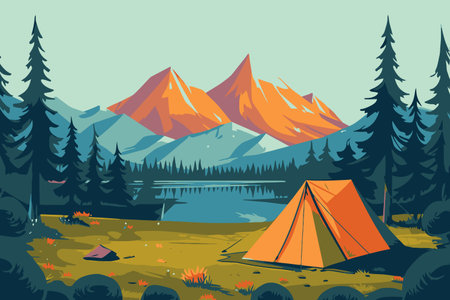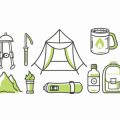Understanding First-Come, First-Served Camping
First-come, first-served (FCFS) camping is a simple and flexible way to experience the outdoors, especially for those who crave spontaneous adventure. Unlike reserved campsites that require booking months in advance, FCFS sites are available to anyone who arrives early enough to claim them on the day of their visit. This approach is rooted in American camping culture—embracing freedom, self-reliance, and the joy of discovering new places without a rigid plan. FCFS camping is ideal for beginners because it removes the pressure of planning far ahead and allows you to explore hidden gems that might not show up on reservation systems. Whether you decide to hit the road last minute or adjust your route along the way, these sites invite you to connect with nature on your own terms. If you’re looking for a more relaxed and adventurous way to camp, understanding how FCFS works is your first step toward memorable outdoor experiences.
Best Times to Arrive and Seasonal Tips
When it comes to snagging a first-come, first-served campsite, timing is everything. Showing up at the right time can mean the difference between a peaceful night under the stars or a long drive to the next campground. Heres how you can maximize your chances:
Arrive Early for the Best Spots
Most campgrounds fill up quickly, especially on weekends and holidays. Plan to arrive early in the morning—ideally before 9 AM—when campers from the previous night are packing up. Midweek arrivals also increase your odds, as crowds tend to thin out Monday through Thursday.
Timing Your Trip: Quick Reference Table
| Day of Week | Best Arrival Time | Crowd Level |
|---|---|---|
| Monday–Thursday | 7 AM–10 AM | Low |
| Friday | 6 AM–8 AM | High (arrive earlier) |
| Saturday–Sunday | 7 AM–9 AM | Medium–High |
| Holiday/Long Weekend | Before sunrise | Very High (plan ahead) |
How Seasons Affect Availability
The season you choose makes a big difference. Summer is peak camping season across most of the United States, especially in national parks and popular state parks. Spring and fall offer milder weather and fewer crowds, making them ideal for beginners who want a quieter experience.
Seasonal Availability Guide
| Season | Availability Level | Special Notes |
|---|---|---|
| Spring (Mar–May) | Medium–High | Watch for muddy trails; some sites may be closed due to weather. |
| Summer (Jun–Aug) | Low (most crowded) | Arrive extra early; expect full lots by noon. |
| Fall (Sep–Nov) | Medium–High | Cooler temps, beautiful foliage, more open sites after Labor Day. |
| Winter (Dec–Feb) | High (least crowded) | Limited amenities; check for seasonal closures. |
Pro Tips for Timing Your Camping Trip
- If possible, avoid major holidays like Memorial Day, Fourth of July, and Labor Day when campgrounds are busiest.
- Check park websites for current conditions and any early closures due to weather or maintenance.
- If you’re flexible, plan last-minute trips based on midweek weather forecasts for more solitude and better site selection.
With a little planning and flexibility, youll discover that camping without reservations opens the door to spontaneous adventures and hidden gems—no booking required.

3. How to Find These Campsites
Finding first-come, first-served campsites is easier than ever thanks to a blend of digital resources and local know-how. Begin your search with official park websites—they’re often the most accurate source for updated campsite status, rules, and tips on arriving early. Most national and state park sites have sections dedicated to camping info, including real-time updates on availability. If you prefer human connection, stop by a local ranger station. Rangers offer firsthand knowledge about lesser-known spots and current site conditions, and they might even share hidden gems nearby. For tech-savvy campers, popular apps like Recreation.gov, The Dyrt, and Campendium let you filter for non-reservable sites. User reviews and recent photos can give you a sense of each location before you arrive. Don’t forget to check social media groups or local camping forums—these communities are filled with experienced campers who love sharing timely advice about open sites and best arrival times. By combining these trusted resources, you’ll increase your chances of finding an open spot and create a smoother entry into the world of spontaneous camping.
4. What to Pack for Flexible Camping
When you camp without reservations, packing light and smart is key. Minimalism keeps you nimble—ready to adapt if plans change or sites are full. Focus on essentials that offer comfort, support sustainability, and help you thrive wherever you land.
Minimalist Camping Packing List
| Category | Essential Items | Why It Matters |
|---|---|---|
| Shelter & Sleep | Tent or tarp, sleeping bag (season-appropriate), sleeping pad, headlamp | Stay warm, dry, and rested—flexible for any site |
| Cooking & Eating | Lightweight stove, reusable utensils, collapsible cookware, food in bear-proof containers, water filter or purifier, reusable water bottle | Sustainable choices cut waste and keep you fueled anywhere |
| Clothing | Layered outfits (weather-ready), packable rain jacket, hat, extra socks and underwear | Adapt to changing weather; easy to wash and quick to dry |
| Health & Hygiene | Eco-friendly soap, toothbrush/paste, quick-dry towel, small first aid kit, biodegradable wipes | Leave no trace while staying clean and safe |
| Navigation & Safety | Pocket map or downloaded offline maps, compass, whistle, multi-tool, extra batteries or charger | Stay found and ready for surprises at new campsites |
| Extras (Optional) | Campsite chair/stool, journal/pen, minimal games/cards, small trash bag for packing out waste | Add comfort but stay light—prioritize what brings joy without cluttering your pack |
Packing Tips for First-Come Campers
- Edit ruthlessly: If it doesn’t serve multiple purposes or bring real comfort, leave it behind.
- Avoid single-use items: Choose reusable gear to reduce waste and adapt to different sites.
- Pack for the unknown: Weather shifts and site conditions change fast. Versatile gear keeps you ready.
- Sustainability matters: Opt for eco-friendly products and always follow Leave No Trace principles.
- Stay organized: Use packing cubes or stuff sacks so you can quickly grab what you need when moving between sites.
This minimalist approach frees you from excess and lets you experience the wild with clarity. With just the basics—and a flexible mindset—you’re prepared for whatever your reservation-free camping adventure brings.
5. Campground Etiquette and Eco-Friendly Practices
When you’re camping at first-come, first-served sites, understanding campground etiquette is essential for a peaceful experience. Respect quiet hours—most campgrounds in the U.S. have posted times when noise should be kept low. Keep your site tidy by storing food properly and picking up trash, even if it’s not yours. Practice the golden rule: leave your spot better than you found it.
Respect Your Neighbors
Give fellow campers their space. Avoid walking through other campsites, keep pets leashed and under control, and use low voices, especially at night. Small gestures—like waving hello or helping someone set up—can go a long way in creating community.
Leave No Trace Principles
Tread lightly on the land by following Leave No Trace principles. Pack out what you pack in, including all trash and leftover food. Use established fire rings if fires are allowed, and only collect dead and down wood. If there are no restroom facilities, bury waste at least 200 feet from water sources.
Eco-Friendly Choices Matter
Opt for biodegradable soaps and reusable containers to minimize waste. Stick to marked trails to prevent damaging fragile plants. Be mindful of wildlife—observe from a distance and never feed animals.
The Unwritten Rules
Many seasoned campers appreciate a simple wave or nod—a silent acknowledgment of shared respect for nature and solitude. If you arrive late or leave early, do so quietly to avoid disturbing others.
By embracing these unwritten rules and eco-friendly habits, you help preserve America’s wild spaces for everyone who comes after you—and make your own camping experience more rewarding.
6. Troubleshooting: Plan B When Sites Are Full
Sometimes, even the best plans meet a full campground sign. Don’t let this discourage your adventure—having a flexible mindset and backup strategies can turn disappointment into discovery.
Scout Nearby Alternatives
If your first-choice site is packed, check for other first-come, first-served campgrounds nearby. Many national forests and state parks have lesser-known sites just down the road. Local ranger stations are great resources—they often know which sites fill up fastest and can recommend hidden gems in the area.
Embrace Dispersed Camping
In many public lands across the U.S., dispersed camping is allowed outside developed campgrounds. While these spots lack amenities like restrooms or water, they offer solitude and a deep connection with nature. Always follow Leave No Trace principles to protect these wild places for future campers.
Try Walk-In or Hike-In Sites
Some parks set aside walk-in or hike-in campsites for late arrivals. These are usually less crowded and can lead you to beautiful, quiet corners of the park. Be ready to carry your gear a short distance, and enjoy the peace away from busy loops.
Ask About Overflow Options
Some campgrounds offer overflow areas for those who arrive after all regular sites are taken. These may be basic but provide a legal and safe place to spend the night.
Get Creative With Your Stay
If official campgrounds are full, look into alternative accommodations nearby—like local motels, RV parks, or even “hipcamp” style options on private land. Sometimes, small towns near popular parks have community parks or fairgrounds that allow overnight camping for a small fee.
With flexibility and an open mind, you’ll find that sometimes Plan B leads to unexpected beauty and memorable experiences on your camping journey.


